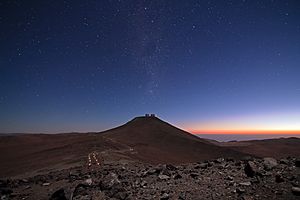Naked eye facts for kids

When we talk about seeing something with the naked eye, it means looking at it without any special tools. This includes things like a telescope, binoculars, or a microscope. In astronomy, a naked-eye object is something in space, like a star or a planet, that most people can see clearly without needing any optical help.
Contents
What Can You See with Your Naked Eye?
You might be surprised by how much you can see just by looking up at the sky! On a clear night, far away from city lights, you can spot many amazing things.
Stars and Constellations
You can see thousands of stars with your naked eye. These stars form patterns called constellations. Some famous ones include the Big Dipper, Orion, and Cassiopeia. Learning to find these can be a fun way to explore the night sky.
Planets in Our Solar System
Several planets in our Solar System are bright enough to be seen without a telescope.
- Mercury is tricky to spot because it's very close to the Sun. You can sometimes see it low in the sky just after sunset or before sunrise.
- Venus is often the brightest object in the sky after the Moon. It's sometimes called the "morning star" or "evening star."
- Mars shines with a reddish glow. Its brightness changes depending on how close it is to Earth.
- Jupiter is very bright and looks like a steady, yellowish-white star.
- Saturn is also visible, appearing as a yellowish "star." You can't see its rings without a telescope, but it's still cool to know you're looking at it!
The Moon and Milky Way
Of course, the Moon is the easiest and brightest object to see with your naked eye. You can watch its different phases throughout the month. On very dark nights, away from light pollution, you can even see the faint, cloudy band of the Milky Way galaxy stretching across the sky. This is our home galaxy!
Other Sky Objects
Sometimes, you can see other interesting things:
- Meteors (shooting stars) are tiny bits of space rock burning up in our atmosphere. They appear as quick streaks of light.
- Comets can occasionally become bright enough to see without a telescope, especially if they pass close to Earth and the Sun.
- Satellites like the International Space Station (ISS) can look like slow-moving, bright "stars" crossing the sky.
Why Can We See Some Things and Not Others?
Whether you can see something with your naked eye depends on a few things:
- Brightness: How much light an object gives off or reflects. Brighter objects are easier to see.
- Distance: How far away the object is. Closer objects usually appear brighter.
- Size: Larger objects can sometimes be seen even if they are far away, as long as they are bright enough.
- Light Pollution: City lights make the sky brighter, making it harder to see fainter objects like many stars or the Milky Way. Dark skies are best for stargazing.
- Atmosphere: A clear, stable atmosphere helps you see objects more sharply.
See also
 In Spanish: Simple vista para niños
In Spanish: Simple vista para niños

